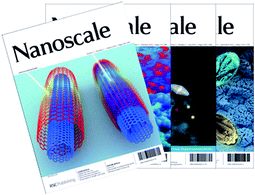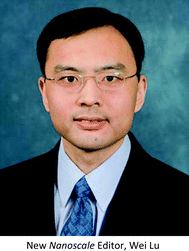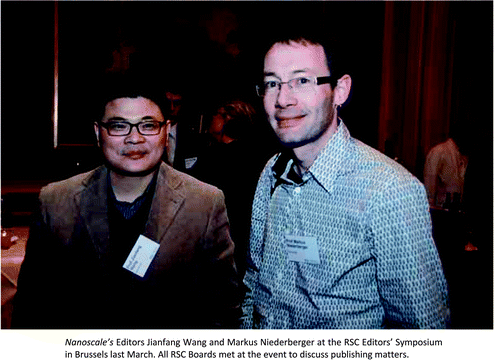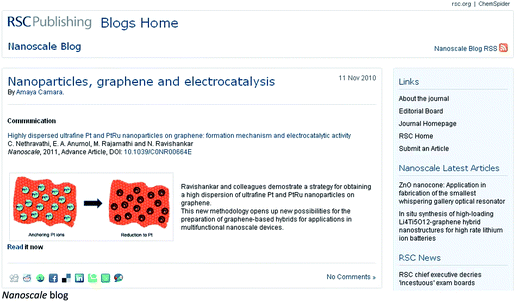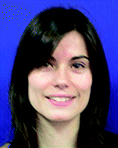Nanoscale: a bright future
The beginning of a new year is time to celebrate past events and look ahead to the future… keep on reading and celebrate Nanoscale's success with us!
A plentiful year
In just one year since its launch in late 2009, Nanoscale has strengthened its position at the heart of the nano-community (in the ‘biggest’ sense of the word!), publishing significant, high-quality content from across the world.2010 has seen ongoing and significant growth in Nanoscale submissions. From the synthesis of nanomaterials to self-assembly and molecular organisation, from nanophotonics to biomimetic materials, from theoretical modelling to nanofabrication of devices; the work published in Nanoscale's mix of Reviews, Feature Articles and original research articles appeals to researchers in academia and industry, covering the whole breath of nanoscience and nanotechnology.
For some examples of our great content see Table 1, where we have put together some of our most accessed articles since our launch. For more information on the scope, different article types and author guidelines, visit our website at www.rsc.org/nanoscale.
| Title | Article type | Authors | DOI |
|---|---|---|---|
| Current directions in core–shell nanoparticle design | Review | Wolfgang Schärtl | 10.1039/C0NR00028K |
| Preparation of graphene by a low-temperature thermal reduction at atmosphere pressure | Paper | Wufeng Chen and Lifeng Yan | 10.1039/B9NR00191C |
| Upscaling of polymer solar cell fabrication using full roll-to-roll processing | Feature Article | Frederik C. Krebs et al. | 10.1039/B9NR00430K |
| Solution synthesis of one-dimensional ZnO nanomaterials and their applications | Review | Yulin Deng et al. | 10.1039/C0NR00047G |
| Covalent modification and exfoliation of graphene oxide using ferrocene | Paper | T. Govindaraju et al. | 10.1039/C0NR00024H |
| Nano active materials for lithium-ion batteries | Review | Haoshen Zhou et al. | 10.1039/C0NR00068J |
| A nanostructured graphene/polyaniline hybrid material for supercapacitors | Paper | Xin Wang et al. | 10.1039/C0NR00224K |
| Uniform and controllable preparation of Au–Ag core–shell nanorods using anisotropic silver shell formation on gold nanorods | Paper | Yasuro Niidome et al. | 10.1039/C0NR00130A |
| Smart nanocontainers and nanoreactors | Review | Jan C. M. van Hest et al. | 10.1039/B9NR00409B |
| Microwave chemistry for inorganic nanomaterials synthesis | Feature Article | Idalia Bilecka and Markus Niederberger | 10.1039/B9NR00377K |
We invite you to join the list of leading researchers publishing in Nanoscale by submitting your best research today via our online submission service.
A team up to the challenge
Nanoscale is the result of a truly international effort, with an enthusiastic Editorial team who are up to the challenge of ensuring that our new journal thrives. Our international Editors Chunli Bai, Marcus Niederberger, Francesco Stellacci, Jianfang Wang and newly appointed Wei Lu, conduct a rigorous yet fair peer-review system to make sure the work published in Nanoscale is of the highest quality. We would also like to take this opportunity to thank our referees for their dedication and support.The Editors are supported by our Editorial Offices in Beijing and Cambridge, with a team of highly-qualified professional Publishing Editors overseeing the publication of Nanoscale; the whole team are committed to offering an exceptional service to our authors, referees and readers.
Our international Advisory Board of expert researchers is also growing; we want to welcome to the Nanoscale team our two new members Pedro Gómez-Romero (CSIC-UAB, Spain) and Hong-Bo Sun (Jilin University, China).
Exposure of Nanoscale
Nanoscale's achievement of becoming one of the reference journals for the nano-communities in just its first year, was acknowledged by the inclusion of the journal in both ISI and MEDLINE, the prestigious US National Library of Medicine's premier bibliographic database. All the work published in Nanoscale, backdating to our first issue, is now indexed and searchable in both databases, increasing the visibility of the work published in the journal even further.The high quality research published in Nanoscale continues to be a source of news; with Piero Baglioni's article on art preservation (10.1039/C0NR00255K) and Yen-Hsun Su's article on gold nanoparticle induced luminescence in leaves (10.1039/C0NR00330A) being featured in Chemistry World, and the latter was also highlighted in New Scientist.
Themed issues
2010 also saw the publication of the first two Nanoscale themed issues: ‘Doped Nanostructures’ in July and ‘Crystallization and Formation Mechanisms of Nanostructures’ in November, with contributions from Alexander Star (10.1039/C0NR00043D) and Jean-Olivier Durand (10.1039/C0NR00096E), and Luis Liz-Marzán (10.1039/C0NR00239A) and Stephen Mann (10.1039/C0NR00382D) amongst others.Nanoscale has more exciting issues planned on hot topics across the scope of the journal, including ‘Surface Nanotechnology for Biological Applications’, ‘Optical Materials’, ‘Lithography’, ‘Enabling Platforms in Nanotechnology’ and ‘Modelling for the Nanoscale’. If you have a suggestion for a new themed issue, please do contact us at E-mail: nanoscale@rsc.org.
Subscribe to Nanoscale
All Nanoscale's content has been free to access online for everyone since its launch until the end of 2010. This free-access period has now expired, so to continue reading the great work published in Nanoscale, your institution now needs to subscribe to the journal. Please recommend Nanoscale to your librarian to keep in touch with the latest and best research in cutting-edge nanoscience and nanotechnology. More information is available at www.rsc.org/nanoscale.So, what's happening in 2011?
Big things await Nanoscale in 2011. Great content starting in this, our first issue of the year: check our impressive table of contents which includes a review on using far-field optics to read and write at the nanoscale by Françisco Raymo (10.1039/C0NR00546K), an overview of 2D materials by Félix Zamora (10.1039/C0NR00323A), and original research contributions from Julius Vancso on scanning near-field ellipsometry microscopy (10.1039/C0NR00530D), and Xingbin Yan on supercapacitors (10.1039/C0NR00470g) as well as many more. Great events: we will be at ChinaNano, NanoToday, and the ACS, Fall MRS and EMRS meetings, please do come and say hello if you are there. And, of course, the announcement of our first official Impact Factor in June.We will continue to sponsor a variety of relevant international scientific meetings in 2011 and plan to award Poster Prizes to some of the best up-and-coming new scientists in nanoscience and nanotechnology. If you have any suggestions for conferences where we could offer sponsorship or prizes please do let us know at E-mail: nanoscale@rsc.org.
Stay in the loop
If you want to be a part of the Nanoscale community and kept up-to-date, visit our blog, where we share news and the latest developments of interest for our wide community of readers and authors. You can also be a fan of Nanoscale's Facebook† page or a follower on Twitter‡ (or both!) That way, you can keep track of the latest articles published online, relevant news, or connect with fellow researchers with the same interests.Don't forget that you can also sign up to our free table-of-contents alert and Nanoscale Newsbites newsletter at www.rsc.org/alerts.
The future is bright
Nanoscale's success so far is the result of the commitment and support of our community of Board Members, authors, referees and readers; we wish to thank you all sincerely for your contributions.We always welcome your comments, suggestions and feedback; please contact us at E-mail: nanoscale@rsc.org.
From our part, we'll carry on working hard, making sure we are there for the broad nano-community we serve.
Happy New Year!
Amaya Camara
Development Editor, Nanoscale
Philip Earis
Managing Editor, Nanoscale
RSC publishing
Quality and growth continues
It's quality that really matters at RSC Publishing. And the 2009 Journal Citation Reports® proved that our quality is better than ever, as our average impact factor (IF) rose from 4.9 to 5.4. It's an impressive figure, especially when compared with the average for a chemistry journal of 2.4.But we don't rely on just one or two titles to boost our average. It's our entire collection that counts: of the top 20 journals in the multidisciplinary chemistry category, 25% are from RSC Publishing; and 90% of our titles have an IF over 3.
Our list of titles continues to grow: Food & Function and Catalysis Science & Technology are the latest titles to join our expanding portfolio. Plus, the number of articles we've published has increased by 74% in the last 2 years alone. We remain committed to providing a world-class publishing service to our authors, and delivering cutting-edge chemical science to readers throughout the world.
The IF and article growth figures provide a clear indication that more researchers than ever before are recognising journals from the RSC as a key resource to access the very best research.
2011 Books
With steady front-list growth and cutting-edge content, delivering excellence and authority, the RSC is one of the world's leading chemical science print and online book publishers.Nearly 1000 eBooks, equating to one third of a million pages, the RSC eBook Collection delivers outstanding online research and opinion in a multitude of areas of the chemical sciences. Nine new RSC eBook Subject Collections offer additional flexibility.
With over 90 new print titles planned for 2011, including: second editions of seminal texts; and new RSC Polymer Chemistry and RSC Metallobiology series launching, our contribution to chemistry collections worldwide is diverse, topical and high impact. Expect another first class collection of best selling chemical science titles in 2011.
New RSC publishing platform
Access one million journal articles and book chapters in one simple integrated search.The new RSC Publishing platform has been developed in consultation with the international scientific and librarian community. Together we have identified the best and most valued interface and features that connects you with the highest quality scientific research. With one single search box, easily access our books, journals and databases for students, academics, researchers, scientists and professionals.
Free online access
Free online access is available to all our newest journals, and more – all you need to do is register for an RSC Publishing personal account. Then, when you are logged in, you will be able to access all our free content. Currently this includes:• All content of our newest journals for the first 2 volumes
• Any articles that are part of a special free access promotion (e.g. ‘hot’ papers, web theme issues, etc.)
• All journal content published more than two years ago (dating back to 1997)
• A sample chapter from each book in the RSC eBook Collection
With your username and password you can access the free content any time, any place – all you need is internet access. Register at www.rsc.org/personalregistration.
If your institution is a current customer with IP registered, you will be able to access all free content. Other institutions can apply for free online access to our newest journals using our online form: www.rsc.org/freeaccess.
ChemSpider
Have you heard about the RSC's award winning chemical structure and text based search engine – ChemSpider? It's FREE!ChemSpider provides access to:
• millions of chemical structures
• an abundance of additional property information
• tools to upload, curate and use the data
• a multitude of other online services like the RSC Publishing Platform
ChemSpider is one of the richest single sources of structure-based chemistry information.
Visit www.chemspider.com (for mobile devices: cs.m.chemspider.com)
International Year of Chemistry 2011
IUPAC (in conjunction with the UN and UNESCO) have proclaimed 2011 as the International Year of Chemistry (IYC), the goals of which are: to increase the public appreciation of chemistry in meeting world needs; to encourage interest in chemistry among young people; and to generate enthusiasm for the creative future of chemistry.The RSC will be leading the way in IYC 2011, supporting this important initiative through a series of events and activities.
Footnotes |
| † Nanoscale official Facebook page: www.facebook.com/pages/Nanoscale/260036845356 |
| ‡ Nanoscale official Twitter page: http://twitter.com/nanoscale_rsc |
| This journal is © The Royal Society of Chemistry 2011 |

